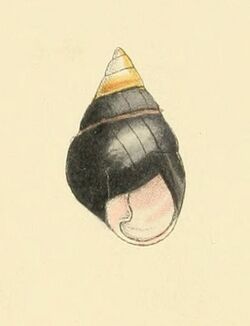Biology:Achatinella apexfulva
| Achatinella apexfulva | |
|---|---|

| |
| Drawing of a shell of Achatinella apexfulva | |
| Scientific classification | |
| Domain: | Eukaryota |
| Kingdom: | Animalia |
| Phylum: | Mollusca |
| Class: | Gastropoda |
| Subclass: | Heterobranchia |
| Order: | Stylommatophora |
| Family: | Achatinellidae |
| Genus: | Achatinella |
| Subgenus: | Achatinella |
| Species: | †A. apexfulva
|
| Binomial name | |
| †Achatinella apexfulva (Dixon, 1789)[2]
| |
| Synonyms | |
|
List
| |
Achatinella apexfulva is a reportedly extinct species of colorful, tropical, arboreal pulmonate land snail in the family Achatinellidae, once present on Oahu, Hawaii. A. apexfulva is the type species of the genus Achatinella. The specific name, apexfulva, meaning "yellow-tipped", refers to the yellow tip of the snail's shell. Inspired from the taxon, the species has been given common names such as yellow-tipped Oʻahu tree snail[3] or Hawaiian yellow-tipped tree snail.[4]
Taxonomy
The family Achatinellidae, to which Achatinella apexfulva belongs, represents a diverse adaptive radiation. All species of tree-snail in Hawaii are believed to have come from a single ancestral snail. How that ancestral snail made the 3,800 kilometres (2,400 mi) trip across the ocean is unknown. A longstanding theory is that a bird carried a notably smaller ancestor across the ocean and dropped it on the islands, as bird mediated dispersal has been documented in other snail species. Alternative theories include that it floated across the ocean on a mat of debris, or that it island-hopped across the Pacific in a combination of the theories. Within the Achatinellidae, A. apexfulva belongs to the Oahu clade, which evolved on Oahu island and includes most other members of the genus Achatinella.[5]
Distribution
This species was endemic to forests of the island of Oahu in the Hawaiian archipelago, United States , but is now extinct.[6] It was listed as federally endangered since 1981.[7] A major cause of its population decline in the wild was predation by the rosy wolfsnail. The rosy wolfsnail, a central-American native, was introduced to Hawaii in the 1950s to control agricultural pests.[8] However, as a carnivore of other snails it does not discriminate in its choice of food and has been the cause of at least eight other snail extinctions in Hawaii.[9]
Other causes of the snail's decline included loss of habitat due to deforestation, introduction of rats, and the introduction of Jackson's chameleon.[10] The problems that A. apexfulva faced are not unique: estimated extinction rates in the family Achatinellidae range between 75% and 90%.[5] The International Union for Conservation of Nature's last study on A. apexfulva was conducted in 1996 and listed the species as Critically Endangered.[1]
George
In 1997, in response to rapidly dwindling populations, all known remaining specimens of A. apexfulva were collected and bred in captivity. Most offspring died of unknown causes, but one successful offspring was born. This individual was named George, after Lonesome George, a Pinta Island tortoise from the Galapagos Islands who was also the last of his kind.[11] By April 2011, George was the only remaining member of the species.[12][13] In January 2019, George died at age 14 – leaving the species reportedly extinct.[14][8][15]
Ecology
While A. apexfulva lived on the leaves of trees, it was not herbivorous. Its diet consisted of algae and mold that it ate off leaves.[10]
References
- ↑ 1.0 1.1 Hadfield, M.; Hadway, L. (1996). "Achatinella apexfulva". IUCN Red List of Threatened Species 1996: e.T168A13038669. doi:10.2305/IUCN.UK.1996.RLTS.T168A13038669.en. https://www.iucnredlist.org/species/168/13038669. Retrieved 17 November 2021.
- ↑ Pilsbry, Henry A. (1912–1914). "Historical Notes on the Literature". Manual of Conchology XXII. https://archive.org/stream/manualofconcholo22tryo/manualofconcholo22tryo_djvu.txt. Retrieved 29 February 2016. "The first Achatinellid shells brought to Europe, so far as we know, were obtained by Captain George Dixon, who visited the Hawaiian Islands in 1786 and 1787. They were strung on a lei or necklace, which seems to have been made entirely of Achatinella apexfulva and A. decora. It appears that four specific names were based upon these specimens.".
- ↑ "Yellow-tipped Oahu Tree Snail (Achatinella apexfulva)". June 8, 2021. http://deadasthedodo.com/2019/01/01/achatinella-apexfulva-dixon/.
- ↑ TenBruggencate, Jan (January 4, 2019). "Last Hawaiian yellow-tipped tree snail dies.". http://raisingislands.blogspot.com/2019/01/last-hawaiian-yellow-tipped-tree-snail.html.
- ↑ 5.0 5.1 Holland, Brenden S; Hadfield, Michael G (August 2004). "Origin and diversification of the endemic Hawaiian tree snails (Achatinellidae: Achatinellinae) based on molecular evidence" (in en). Molecular Phylogenetics and Evolution 32 (2): 588–600. doi:10.1016/j.ympev.2004.01.003. PMID 15223040.
- ↑ Kolbert, Elizabeth (2019-05-20). "Climate Change and the New Age of Extinction". The New Yorker. https://www.newyorker.com/magazine/2019/05/20/climate-change-and-the-new-age-of-extinction. Retrieved 2019-05-13.
- ↑ "Species Profile for Oahu tree snail (Achatinella apexfulva)". https://ecos.fws.gov/ecp0/profile/speciesProfile?spcode=G0CL.
- ↑ 8.0 8.1 "George, Reclusive Hawaiian Snail And Last Of His Kind, Dies At 14" (in en). https://www.npr.org/2019/01/07/682908544/george-reclusive-hawaiian-snail-and-last-of-his-kind-dies-at-14.
- ↑ Kurt Auffenberg & Lionel A. Stange (November 2001). "Snail-eating snails of Florida, Gastropoda". University of Florida. EENY251. Retrieved October 7, 2012.
- ↑ 10.0 10.1 Land & animal & nonanimal. Springer, Anna-Sophie., Turpin, Etienne., Einfeldt, Kirsten., Wolf, Daniela., Haus der Kulturen der Welt.. Berlin: Haus der Kulturen der Welt. 2015. pp. 1–14. ISBN 9780993907418. OCLC 904577335.
- ↑ Bowler, Jacina (January 9, 2019). "Lonely George – A Hawaiian Tree Snail – Has Died, Taking His Species With Him". https://www.sciencealert.com/lonely-george-a-hawaiian-tree-snail-has-died-taking-his-species-with-him.
- ↑ "Achatinella apexfulva". The Recently Extinct Plants and Animals Database. http://cubits.org/theextinctioncubit/db/extinctmolluscsgastr/view/87142/.
- ↑ Thom van Dooren (2013) "The last snail: conservation and extinction in Hawai’i" February 28, 2013. Retrieved 8 January, 2016.
- ↑ "Last known Hawaiian land snail of its kind dies" (in en-US). 2019-01-04. https://www.staradvertiser.com/2019/01/04/breaking-news/last-known-hawaiian-land-snail-of-its-kind-dies/.
- ↑ "World's loneliest snail dies, and a species goes extinct". 2019-01-08. https://www.nationalgeographic.com/animals/2019/01/george-the-lonely-snail-dies-in-hawaii-extinction/.
Wikidata ☰ Q2882019 entry
 |


